 by Robert F. Sharpe, Jr.
by Robert F. Sharpe, Jr.
What is your fundraising strategy?
As we experience persistent drought in parts of the U.S., we are reminded of the importance of water and the rain that deposits it in our lakes, rivers and reservoirs.
Prior to the development of modern atmospheric science and meteorology, humans engaged in all manner of weather modification rituals. Among them were rain dances practiced by various cultures around the world that, when combined with offerings to natural “weather spirits,” were believed to result in prompting the rain necessary to sustain life.
While few, if any, records exist regarding the effectiveness of these rituals, it must have rained often enough for some observers to note and record cause and effect. The practices were continued until humans gradually discovered the science behind whether or not—and when—it should rain.
Misguided metrics
We are reminded of some of the “planned gift marketing” that is being practiced today. Unfortunately, in too many instances it is based on a paucity of reliable information and the misguided intuition that can too often take its place. Unfettered e-marketing to groups of people who are much younger than true bequest prospects, programs that attempt to quantify and monetize income to be received in the distant future from baby boomers and other activities that are common at many nonprofits are in many ways equivalent to “rain dances.” Lots of energy is expended and justified by the fact that some rain in the form of estate gifts (that in most cases would have happened anyway) does occur.
Fortunately, other marketing efforts focused on encouraging bequests and other planned gifts are being conceived and implemented by those who are more interested in the actual science of influencing estate gifts.
In our consulting efforts we are exposed to actual data and the results of past marketing strategies from programs of all sizes. The charts below depict results from two organizations that took very different marketing approaches—and achieved very different results.
In the mid-2000s, Organization A abandoned years of proven marketing strategies and embarked on a marketing program almost exclusively based on online communication—and reaped disappointing results. By contrast, Organization B stuck to proven scientific methods and is meeting goals set out a decade or more ago.
Reading the data
Those in our field who want to truly understand the science behind planned gifts are those who take the time to examine where and why bequests are actually originating. They look at data and hard facts, not the results of surveys in which people may merely be expressing their intentions.
These gift planning “scientists” take the time to profile those who actually include a specific organization in their plans. They then compare these profiles to industry norms for that type of entity and take the steps necessary to influence the behavior of the people who meet that profile.
The factors important for predicting bequests, for example, are normally related to age, longevity and frequency of giving. Some may be surprised to learn that income and gift levels are often of secondary importance where bequests are concerned, as experience reveals the likelihood of a bequest can be inversely related to wealth and lifetime giving levels.
Beware of rating systems that in many cases are little more than instruction manuals for how to conduct expensive and marginally effective “rain dances.” We have reverse-engineered many systems and found that some simply append ages and return a list of the oldest donors who have given more than once or twice, with no attendant analysis of donor patterns and other factors that are highly predictive but are often excluded because they depend on much more labor-intensive subjective analysis not normally available to the data house.
In other cases, vendors will sell a marketing program suggesting mailings to either virtually all donors or all over a relatively young age regardless of the type of gift being marketed. Others give a score for “planned giving” propensity without distinguishing which gift may be best for that donor. Should the donor be targeted with information about a bequest, a gift of appreciated securities, a charitable remainder trust or a life estate gift? Donors of each of these types of gifts have particular “fingerprints” related to age, wealth, income and other factors. With a little effort, prospects for particular types of gifts can be identified largely from an organization’s own records with basic age, wealth and income appends and with analysis that is based on the organization’s (and similar organizations’) actual experiences.
A well-conceived marketing program will not normally be a “one-size-fits-all” effort. One organization may have 10,000 valid prospective bequest donors but fewer than 1,000 people receptive for more sophisticated gifts. Marketing to 10,000 people on every gift plan because they “score” a certain way is not only likely to be a costly misuse of funds, but it can also change the focus of donors at a critical time and lead to disruption of other fundraising initiatives.
It’s time to abandon the “rain dance” mentality even as some labor furiously to supply the “dance steps” and “costumes.” It is better to take a more scientific approach. Use your radar and find the “dark clouds” most likely to contain rain and then carefully “seed” them using the least amount of precious resources necessary. ■
Learn more about how to build a successful gift planning program by attending one of our upcoming seminars. The 2016 seminars are now open for registration. Click here for details.
Robert Sharpe is Chairman of Sharpe Group.


